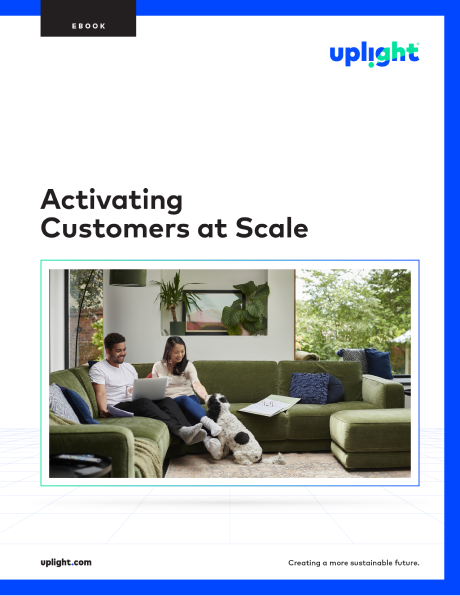The average small-to-medium business (SMB) uses 11x more electricity than an average household—yet these notoriously hard-to-reach customers remain largely disengaged from energy efficiency and demand-side programs.
Uplight’s latest UX research explored the perspectives of 42 SMBs across 12 industries and 26 U.S. states. We investigated SMBs’ energy priorities and perceptions of three key utility Demand Stack programs: time-of-use (TOU) rates, automated smart thermostat demand response (ADR), and behavioral demand response (BDR). The following takeaways reveal what drives SMB participation—and what utilities can do to evolve their program design and promotion strategies for this segment.
1. When it comes to thermostats, convenience is often more important than control.
SMB customers are juggling multiple roles and priorities, with energy management only adding to their very long list of things to do. It makes sense that when given the choice between automated demand response (ADR) and behavioral demand response (BDR), SMBs preferred ADR over BDR by a factor of 2:1. Among the 65% who prefer ADR, their top reason for their choice was to take energy management “off their plate”—regardless of whether they already own a smart thermostat or not. Any perceived risk was lowered by the knowledge they could override ADR events as needed and that pre-cooling/heating would keep both staff and customer comfort at the forefront. Unsurprisingly, for the 35% who prefer BDR, they felt it was critical for operations or regulatory requirements to maintain full control over their thermostat at all times. No matter their program preference, SMBs were adamant that DR programs need to be easy to fit into their existing daily operations, not requiring effortful staff onboarding or training support.
So what? The choice of DR program is highly individual to the needs of the business. When promoting DR programs, utilities should set ADR as the “smart default” for business customers, allowing them to opt into BDR instead as needed. In messaging, it’s critical to emphasize program convenience and clarify that enrolled customers retain ultimate control—no matter which program they participate in.
2. “Normal” bills are top priority.
When asked to rank their energy priorities, SMBs across industries cared most about monitoring the cost of their energy bill and having a consistent, predictable bill each month. SMBs view energy costs as an operational expense to be managed—they want transparency and early warnings when their bill is tracking higher than average. Given that 85% of SMBs are energy bill payers, utilities have a guaranteed monthly outreach touchpoint on energy bills, in auto-pay notifications, and payment workflows to reach this segment when and where they monitor costs.
So what? Utilities can also provide timely insights through alerts and customer portals to keep customers informed about their bill via usage disaggregation—improving customer satisfaction while helping customers take action before they get a high bill.
3. SMBs see demand response as a bill savings program.
Even though DR programs are not bill savings programs, SMBs think differently. 77% of SMBs said energy cost savings make DR programs “worth it”—far outweighing sustainability impact, grid reliability, or public recognition as motivating factors.
Additionally, SMBs want program participation incentives structured as monthly bill credits based on actual performance, rather than end-of-season lump sums or other financial rewards. They expect to see immediate, measurable value on their monthly statements as “fair compensation” for their efforts. This type of incentive structure also meets the expectations of 75% of SMBs who assume that DR programs will decrease their overall energy bill costs.
So what? Utilities should consider designing business ADR and BDR pilot programs with automatic bill credits that emphasize cost savings in their promotion.
4. Enrollment should happen where bills get paid.
SMBs expect to discover and enroll in energy programs through their existing utility touchpoints—specifically online account portals and utility mobile apps where they already pay bills and monitor usage and costs.
SMBs have low comfort levels with default enrollment approaches—they want to maintain control over participation decisions that may affect business operations, costs, and the comfort of staff & customers.
So what? Utilities should take advantage of guaranteed monthly bill-related customer touchpoints to promote DR programs, with clear opt-in digital enrollment pathways.
5. Industry terminology doesn’t always resonate.
The term “peak hours” created confusion among some SMBs who interpreted it as their busiest operational peak periods rather than grid peak periods. This led to initial misunderstandings about when TOU rates would impact their bills.
So what? Adding explicit clarification next to tariff schedule visualizations that peak pricing hours are distinct from business operating hours can help resolve customer confusion.
The bottom line: research insights point toward an SMB approach that provides low-effort programs, bill savings opportunities, and integration with existing utility touchpoints for a simplified enrollment experience.
By aligning program design with how SMBs actually think about energy management, utilities can unlock more participation (and load shift) from this crucial segment.





